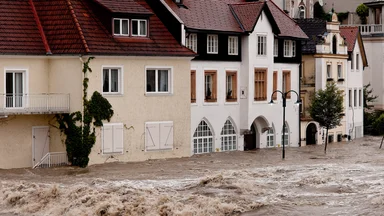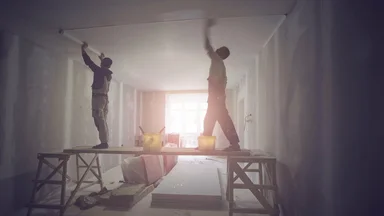4 signs you need a dehumidifier on your construction site

- Home
- Insights
- Humidity control and drying insights
- 4 signs you need a dehumidifier on your construction site
Insufficient moisture control on construction sites can cause costly problems and preventable delays. To avoid these issues, we explore why dehumidifiers are ideal and when to deploy these air drying solutions.
Although high humidity levels are undesirable in any indoor setting, too much moisture on a building site can damage materials, negatively affect workers’ comfort and result in costly delays.
It is not just during the colder winter months when these problems can rear their head. Effective construction climate control and moisture management is a year-round concern for almost every site, whether this is the risk of saturated blockwork in new build properties, to the deterioration of expensive, ornate wood in listed buildings.
How to control humidity on-site
Construction managers should always aim for between 40% and 60% relative humidity (RH) on any building site to maintain optimal conditions for building materials and occupants.
To rid the air of excess humidity, dehumidification technology can create an environment where staff can thrive and building health is maximised. In order to do this, there are two common types of systems – adsorption dehumidifiers and condensation dehumidifiers.
Adsorption dryers, otherwise known as desiccant dehumidifiers, eliminate unwanted moisture by forcing indoor air over a desiccant wheel. As the wheel revolves, this material adsorbs water vapour, releasing dry process air as a result.
Condensation, or refrigerant dehumidifiers, harness another form of dehumidification. These units draw air into the unit and over refrigerant coils. As the air is cooled to its dew point, condensate is collected and drained away, exhausting dry process air.

4 signs you need a dehumidifier
With excessive moisture a constant threat to the condition of building materials, speed of processes and the overall progress of a project – not to mention the discomfort of people on-site – it is important you can identify any red flags.
Here are four of the clearest warning signs that you need to get the humidity under control.

1. Condensation is forming inside
As warm, stale air comes into contact with cold materials, such as metal and glass, condensate can begin to form and rust fittings, damage electronics and trickle behind walls.
To keep the presence of condensation to a minimum indoors and preserve the health of a building, dehumidifiers control the level of humidity in the air.
2. Mould and mildew are growing on-site
Mould spots form as moisture from the air settles on cooler surfaces, often developing if the relative humidity is 70% or more for extended periods of time. As growth progresses, spores saturate inside spaces, quickly becoming an unpleasant and dangerous environment.
Dehumidifiers work to keep spaces free from mould and mildew by capturing and draining water molecules before they are able to rest on surfaces.
3. Musty smells emerge
Over time, musty odours will begin to develop in moist and damp areas. This is often caused by a rising concentration of bacteria, and can subsequently present a health risk to workers with allergies and asthma.
In order to prevent the build-up of unpleasant and harmful odours on building sites, dehumidifiers help to renew air quality and keep indoor atmospheres fresh and healthy.
4. Damage to building materials
Materials such as woods, metals and plaster can be severely affected by the presence of moisture. If humidity levels cause these materials to expand, shrink and warp, they are unlikely to be able to fulfil the same role or fit in their designated space.
This can either place newly constructed sites at risk if they are built with damaged materials, or increase project costs by needing to source replacement materials.

By controlling the levels of water vapour in the air, conditions can stay consistent and prevent certain materials from becoming damaged or destroyed.
What problems can excess moisture cause on-site?
Failing to control and manage humidity levels does not just cause numerous issues for the health and safety of workers and the development of buildings. These effects can have severe and far-reaching consequences throughout a project, such as:

Why are dehumidifiers ideal for construction sites?
As well as being highly capable and effective solutions in their own right, dehumidifiers are optimally suited to construction air drying because they are exceptionally energy efficient, and can help keep project costs to a minimum.
Unlike natural ventilation or heat-only drying, this technology also offers contractors the ability to totally control the level of humidity in their environment. These units enable operators to simply adjust unit settings to suit the specific needs of workers or their materials, so the humidity is kept optimal at all times.
Furthermore, to accommodate the ever-evolving needs of construction work, portable dehumidifiers are deployable when and where required. As a project comes to a close, these systems can then be transported wherever they are required next with ease. These units are also widely available from rental companies to be used on a project-to-project basis.
Plus, because these devices help sites reduce their energy usage, they also help contractors minimise their carbon footprint. Effective implementation of this technology can also keep the amount of waste a single site generates as low as possible.
Debunking moisture-related myths
If you are unsure about your need for a dehumidification unit or believe that there are better ways to resolve this problem, please keep these three details in mind…
Rapid heating does not effectively dry materials – this only sends the moisture into the air. Once the heat is removed, in around 48 hours the moisture equilibrium will return and the moisture in the atmosphere will return to the building fabric.
Opening windows during the summer will not fix the problem – if the relative humidity outside is greater than inside, this can actually bring more moisture into the atmosphere, worsening the problem.
Condensation is not only an issue in the winter – condensation occurs when cool air meets hot air. During the summer with a high relative humidity, moisture is just as much a problem for construction project managers.
How to choose the optimal unit
To effectively and efficiently remove moisture from the air, it is important to carefully choose the right type of dehumidifier for your needs. As part of this process, building contractors must consider the following factors:

To help you make your choice with greater ease, read our guide to selecting the best commercial dehumidifiers.
Dehumidify with clarity and confidence
Water stains. Condensation. Musty smells. These are just some of the signs that moisture levels on your site have risen to uncomfortable levels.
To effectively tackle this unwanted moisture and prevent it from causing avoidable damage or delays to your project, Aerial is the manufacturer of choice for many building firms.
Backed by decades of experience, our broad range of dehumidifiers are engineered to high standards and can deliver exceptional performance on building sites all over the world.

It is not just our vast range of high-quality solutions that make us the go-to manufacturer for construction air drying. Our systems are covered by an unprecedented three-year warranty, giving you total reassurance that if anything were to happen to your unit, you are protected.
Aerial units are also underpinned by a vast support network. If you ever require customer service, spare or technical support across our entire selection of products, immediate help is only a phone call away.
To learn more about our cutting-edge dehumidification technology, get in touch with our team of experts today or fill out the form below. We’ll help you determine the optimal unit to meet your needs and budget.
Related products
Featured insights

Explore the factors that influence the amount of time it takes to dry water damage, including the equipment you use.

Explore the core areas of restoring a property following a flood - managing air quality, controlling the climate and building drying.

Keep your building timelines on track.
Need help with choosing the right solution? Our team of over 100 climate control experts can assist.
You can also reach out or join the discussion on our Social Media. Check out our LinkedIn page.





